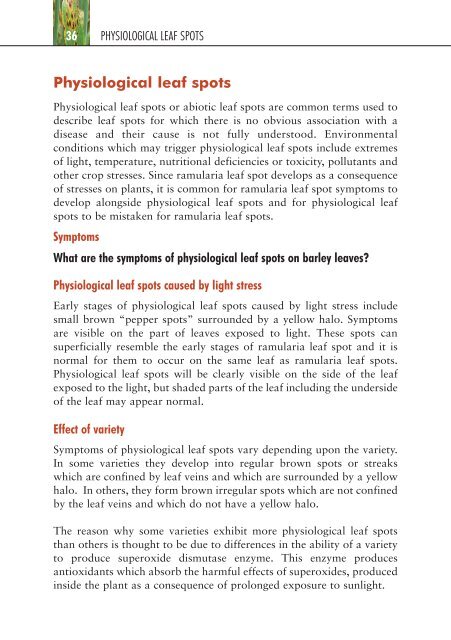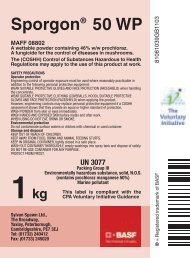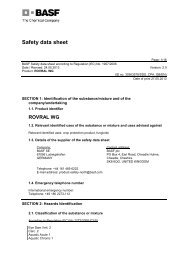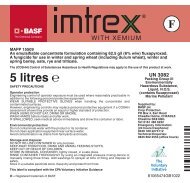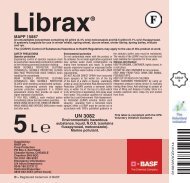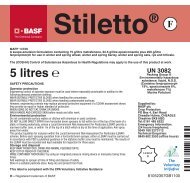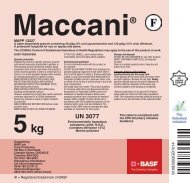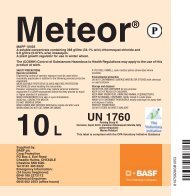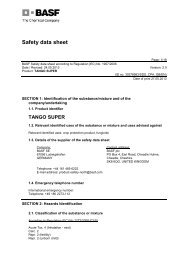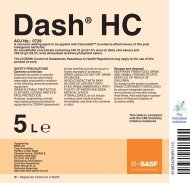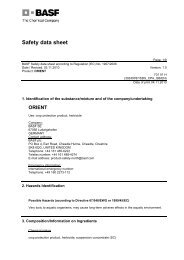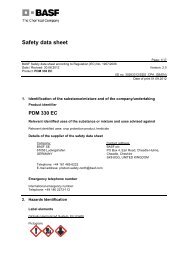a guide to the recognition and understanding of ramularia and other ...
a guide to the recognition and understanding of ramularia and other ...
a guide to the recognition and understanding of ramularia and other ...
Create successful ePaper yourself
Turn your PDF publications into a flip-book with our unique Google optimized e-Paper software.
36<br />
Physiological leaf spots<br />
Physiological leaf spots or abiotic leaf spots are common terms used <strong>to</strong><br />
describe leaf spots for which <strong>the</strong>re is no obvious association with a<br />
disease <strong>and</strong> <strong>the</strong>ir cause is not fully unders<strong>to</strong>od. Environmental<br />
conditions which may trigger physiological leaf spots include extremes<br />
<strong>of</strong> light, temperature, nutritional deficiencies or <strong>to</strong>xicity, pollutants <strong>and</strong><br />
o<strong>the</strong>r crop stresses. Since <strong>ramularia</strong> leaf spot develops as a consequence<br />
<strong>of</strong> stresses on plants, it is common for <strong>ramularia</strong> leaf spot symp<strong>to</strong>ms <strong>to</strong><br />
develop alongside physiological leaf spots <strong>and</strong> for physiological leaf<br />
spots <strong>to</strong> be mistaken for <strong>ramularia</strong> leaf spots.<br />
Symp<strong>to</strong>ms<br />
What are <strong>the</strong> symp<strong>to</strong>ms <strong>of</strong> physiological leaf spots on barley leaves?<br />
Physiological leaf spots caused by light stress<br />
Early stages <strong>of</strong> physiological leaf spots caused by light stress include<br />
small brown “pepper spots” surrounded by a yellow halo. Symp<strong>to</strong>ms<br />
are visible on <strong>the</strong> part <strong>of</strong> leaves exposed <strong>to</strong> light. These spots can<br />
superficially resemble <strong>the</strong> early stages <strong>of</strong> <strong>ramularia</strong> leaf spot <strong>and</strong> it is<br />
normal for <strong>the</strong>m <strong>to</strong> occur on <strong>the</strong> same leaf as <strong>ramularia</strong> leaf spots.<br />
Physiological leaf spots will be clearly visible on <strong>the</strong> side <strong>of</strong> <strong>the</strong> leaf<br />
exposed <strong>to</strong> <strong>the</strong> light, but shaded parts <strong>of</strong> <strong>the</strong> leaf including <strong>the</strong> underside<br />
<strong>of</strong> <strong>the</strong> leaf may appear normal.<br />
Effect <strong>of</strong> variety<br />
PHYSIOLOGICAL LEAF SPOTS<br />
Symp<strong>to</strong>ms <strong>of</strong> physiological leaf spots vary depending upon <strong>the</strong> variety.<br />
In some varieties <strong>the</strong>y develop in<strong>to</strong> regular brown spots or streaks<br />
which are confined by leaf veins <strong>and</strong> which are surrounded by a yellow<br />
halo. In o<strong>the</strong>rs, <strong>the</strong>y form brown irregular spots which are not confined<br />
by <strong>the</strong> leaf veins <strong>and</strong> which do not have a yellow halo.<br />
The reason why some varieties exhibit more physiological leaf spots<br />
than o<strong>the</strong>rs is thought <strong>to</strong> be due <strong>to</strong> differences in <strong>the</strong> ability <strong>of</strong> a variety<br />
<strong>to</strong> produce superoxide dismutase enzyme. This enzyme produces<br />
antioxidants which absorb <strong>the</strong> harmful effects <strong>of</strong> superoxides, produced<br />
inside <strong>the</strong> plant as a consequence <strong>of</strong> prolonged exposure <strong>to</strong> sunlight.


